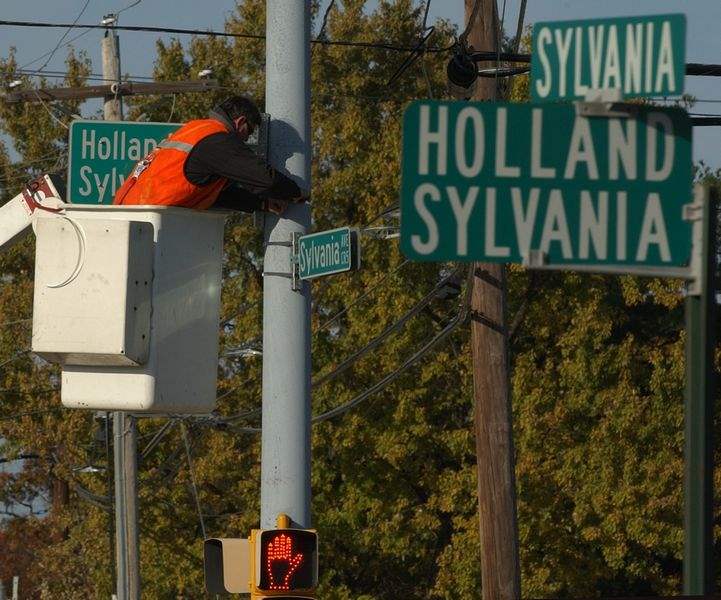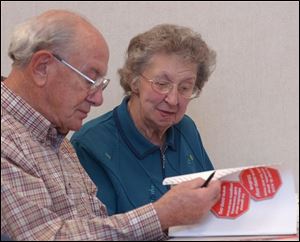
Seniors must balance driving, aging process
10/27/2003
Dave Durfey installs a larger, more reflective road sign at the Holland-Sylvania and Sylvania Avenue intersection. Crews are replacing signs throughout Lucas County to help combat failing eyesight for seniors and other drivers.
Hires / Blade

Dave Durfey installs a larger, more reflective road sign at the Holland-Sylvania and Sylvania Avenue intersection. Crews are replacing signs throughout Lucas County to help combat failing eyesight for seniors and other drivers.
Accidents happen, but for Everett Hargrove, they may have happened one too many times.
One person is dead. Another has lost her leg.
And now investigators say they plan to pursue felony charges against the 75-year-old man after his second collision with a motorcycle in just over two years.
“The statute allows it [for a felony] if there's willful, wanton disregard for the safety of others,” Lucas County assistant prosecutor Jeff Lingo said. “And what concerns is me that this is the second time in [about] two years.”
On Sept. 9, Mr. Hargrove's car collided with a motorcycle ridden by Nancy Hejl, 40, of Wild Pleasant Drive, on Sylvania Avenue, just west of McCord Road, in Sylvania Township.
It wasn't the first accident for Mr. Hargrove, of Homer Street.
About two years earlier, another collision in which he was involved killed the motorcyclist. Both days were sunny and clear. And in both incidents, Mr. Hargrove allegedly pulled out of a private drive into the path of the motorcyclists.
Though Mr. Hargrove certainly is not being charged because of his age, the case is thrusting into the spotlight the issue of senior drivers - a topic that already has attorneys, lawmakers, traffic safety experts, and even engineers talking.
Consider that there were 19.1 million licensed drivers 70 years or older in the United States in 2001. By 2020, that number is expected to swell to 30.7 million drivers in that same age group, according to Jason King, spokesman for the American Association of Motor Vehicle Administrators.
And of course, no one is suggesting that folks have to relinquish their keys after a certain birthday.
“There is no magic number,” Mr. King said. “You can't say: `OK, at 65 you start falling apart,'” he said, noting that his 85-year-old grandfather is an “excellent” driver, while his 75-year-old grandmother is in a nursing home with dementia.
Added Ohio Highway Patrol spokesman Sgt. Robin Schmutz: “You have to look at something else: Seniors are more experienced.
“So for some, they're actually much better drivers” than younger motorists, she said.
In fact, drunks and inexperienced drivers are proving to be much greater risks on the roads.
In 2000, 7,956 teenage drivers were involved in fatal accidents throughout the United States, compared to 10,944 drivers in the much larger age group - those who were 55 or older, according to the National Highway Traffic Safety Administration.
The younger drivers were more likely to be intoxicated, speed, or otherwise drive recklessly, according to traffic safety experts.
That being said, aging takes its physiological toll on some seniors, making it more difficult both for driving and for surviving a serious accident.
“Maybe the younger person has a whole raft of chest injuries, bunch of busted ribs, they will have trouble breathing, maybe, but will be able to get through,” said Lucas County Coroner Dr. James Patrick, “whereas the 70-year-old with emphysema and rib fractures will end up on a respirator with no question.”
Statisticians call it the U-Curve.
The younger you are as a driver, the better chance you have of becoming a traffic fatality. Those odds drop through the 30s, 40s, and most of your 50s, but then begin to climb again in the senior years.
Some age-related physiological changes are obvious: deteriorating vision and hearing, and decreasing flexibility and muscle strength that can make it tougher to glance over shoulders or react quickly to a sudden obstacle.
There are more subtle changes too.

Toledo seniors Francis and Melva Fry look over literature during a driving course at MCO's Collier Building.
Perhaps most frustrating for drivers - and those around them - is the increasing difficulty in focusing and decision-making.
Blame it on acetylcholine.
For some, the brain kicks out less and less of the chemical as the years wear on, making it tougher to focus and easier to be distracted, said Dr. Kevin Pang, one of two Bowling Green State University professors who recently were awarded a $1 million grant from the National Institute on Aging to study aging and the chemical.
Consider a routine errand and a left turn.
As the younger driver approaches the intersection, he checks lanes and mirrors, gauges his speed, and turns the wheel in what seems to be a fluid, split-second motion.
Now compare your computer today with your first PC.
“You and I can do it very quickly, so it appears we're doing it simultaneously,” Dr. Pang said. “But if you slow it down like an old computer, it becomes very obvious that we're not doing all of these things at the same time.”
For a senior, the sequence slows.
Where's the signal? How far away is it? Where are the other cars? What is my speed? Is it too fast? Am I OK to change lanes? What about that big semi I just saw? What color is the light? How soon before it turns red?
And where was I going, anyway?
Add to that the trouble processing partial pictures - a bicycle wheel jutting out from between one of the parked cars, for example.
“You should be able to figure there's a bicyclist who might be coming along,” said Esther Wagner, a program analyst with NHTSA. An older person may “just see a wheel and not foresee what's behind it.”
The numbers tell the story: according to national statistics, in more than one of every four fatal accidents involving seniors in 2000, the senior driver was turning left.
Now throw into any multi-task type of traffic situation some very common medications used by seniors that can slow down reaction time. And finally mix in the irate driver just a few feet behind who has now laid on the horn.
In those fatal crashes in 2000, the vehicle driven by the older person was more than three times as likely to be the one that was struck.
“The biggest problem is driver distraction,” said Denis Driscoll, Ohio coordinator of the AARP Driver Safety Program.
He's talking about the other drivers: “those people putting on makeup, eating, and talking on cell phones.”
George Schaffer agrees. The retired paint shader recently took the course at Medical College of Ohio Hospitals.
“A person needs eyes in the back of your head now,” he said. “You've got these irresponsible drivers right on your tail. They're not paying attention, they're impatient, and they're trying to make up time because they left the house too late.”
The good news in all of this is that many of the difficulties that some seniors face driving can be corrected - some of it very easily.
Certain exercises improve flexibility and strength. Vision and hearing loss often can be reversed.
And one of the best ways to tweak old driving skills is a national program provided through AARP, the nation's largest organization for older Americans.
The eight-hour course - formerly called 55 Alive - is voluntary and there is no driving test. Completing it can mean a reduction in insurance rates.
Many seniors began driving before current road signage, left turn lanes, or even turn signals. Some never took a driving test, said Bob Creason, a local instructor.
“The roads were different than what we know now,” he said.
Still, neither he nor a host of organizations studying traffic safety are pushing for required testing of seniors before their license is renewed because, simply, bad and good drivers are in all age groups.
“We have some very, very agile seniors out there,” Ms. Neundorfer said. “But that's not across the board.”
Only two states, Illinois and New Hampshire, require age-based tests, mandating drivers who are 75 or older to take a road test when renewing their licenses, Mr. King said.
In Ohio and Michigan, seniors with a clean driving record and no extra medical concerns renew their license like most drivers: with a simple eye test.
To help combat failing eyesight and slow reaction time for seniors - and in fact, other drivers - Lucas County road crews are replacing street signs throughout the county.
The letters are larger by 50 percent or more, and they are more than twice as reflective as the older signs.
Additionally, lighted signs are getting brighter and speed limit signs are getting bigger, Mr. King said.
It costs more. The street signs, for example, cost nearly twice as much, “but what's a person's life worth?” asked Mike Kashmer, a road crew supervisor.
Indeed, the discussion and action over seniors driving should, in fact, be proactive rather than reactive as the population grays, traffic safety advocates say.
That's why classes also educate seniors not only on when they should turn in the keys, but also on other modes of transportation.